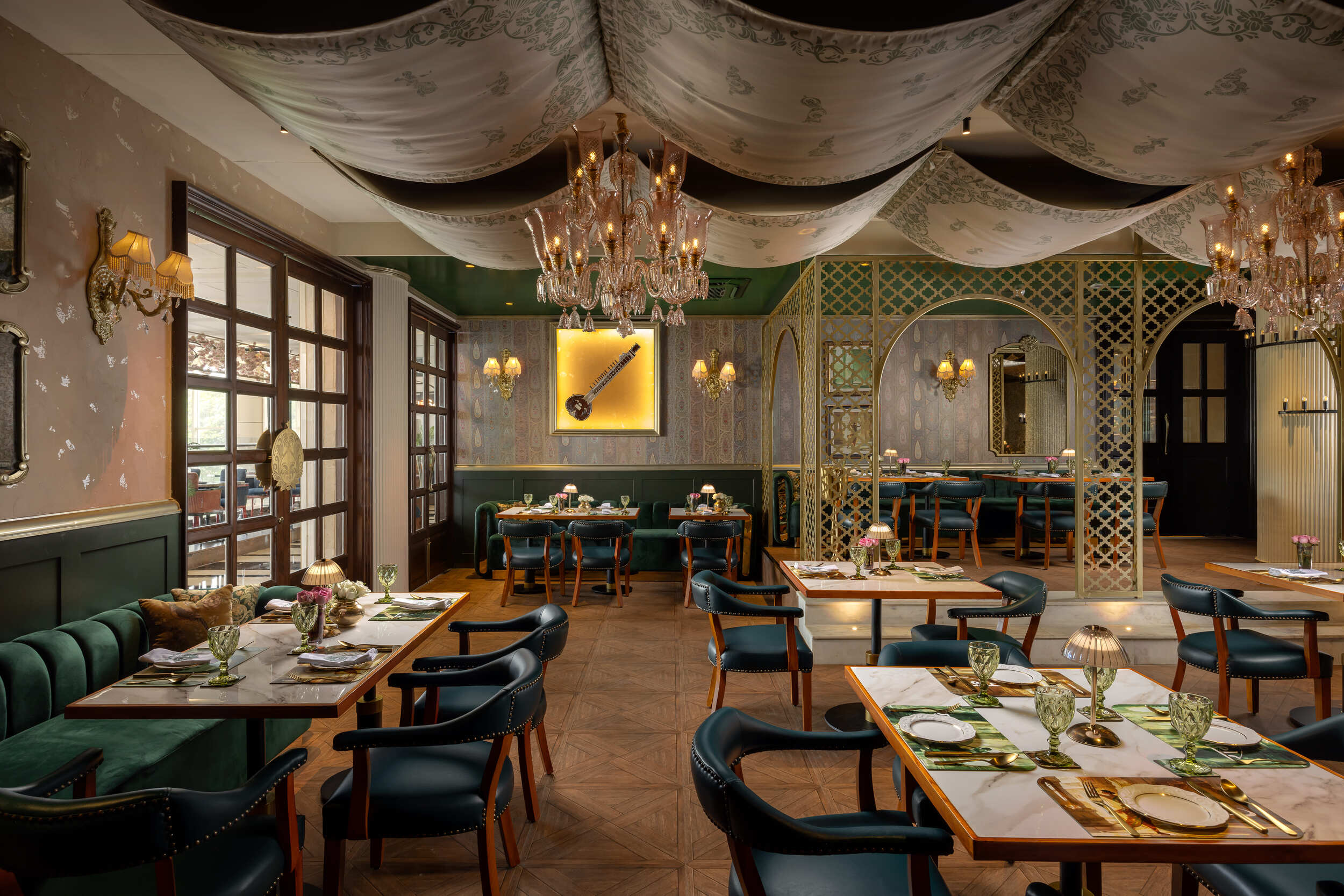Raag: An Ode to Indian Music, Food, and Soul
Raag, meaning “melody” or “mode” in the context of Indian classical music, is an Indian cuisine restaurant designed by LDG Studio. Spanning 1,800 square feet, this thoughtfully curated space seeks to create a symphony that unites the essence of food, music, and soul. Every design element in Raag is carefully chosen to evoke an experience that mirrors the intricacies of a musical performance, where each note plays a vital role in creating an immersive atmosphere.
A Fusion of Tradition and Modernity
Upon entering Raag, one is immediately embraced by a fusion of traditional Indian aesthetics with modern sensibilities. The restaurant’s logo, symbolic of a sitar—a quintessential Indian musical instrument—sets the tone for the space. This logo is not just a graphic representation but is embodied in a focal niche, which features an elegant sitar installation. This niche draws attention as both a visual anchor and a tribute to the classical roots from which the concept of Raag is derived.
A Dance of Colors and Textures
The interior of Raag is dominated by the color green, symbolizing harmony, freshness, and a deep connection to nature. This lush palette is complemented by the warmth of patterned walnut wood flooring, which brings a rich, earthy tone to the space. The flooring design features intricate patterns reminiscent of traditional Indian motifs, creating a seamless blend between the restaurant’s cultural roots and contemporary design.
Walls are a canvas for traditional paisley water-painted designs, adding a touch of Indian heritage through these age-old patterns known for their symbolic meanings of fertility, life, and eternity. The sand-finished walls with golden hints add a layer of luxury and opulence, while their textured surface provides a tactile experience that is both rustic and refined. The incorporation of wainscoting not only enhances the visual depth of the walls but also offers a practical solution for maintaining the restaurant’s elegance over time.
Architectural Elegance with a Cultural Essence
Raag’s spatial layout is cleverly divided into two levels, offering varied dining experiences. The use of arched partitions throughout the restaurant is a nod to classical Indian architecture. These arches serve as both structural elements and design features, giving the space a sense of rhythm and flow, akin to the melodic structure of a raag in music.
Complementing the arches is the intricate jaali work, characterized by its delicate lattice patterns. This traditional Indian craft technique is employed in the partitions and wall panels, creating a play of light and shadow that adds a sense of mystery and depth to the interiors. The jaali not only enhances privacy but also allows glimpses of the adjoining spaces, maintaining a connection between the various sections of the restaurant.
Ceiling as a Canvas of Cultural Expression
One of the highlights of Raag is its draped ceiling, designed to captivate and enchant. The ceiling fabric is printed with dance mudras—traditional hand gestures that are integral to Indian classical dance forms. These mudras, depicted in fluid lines and graceful poses, tell a story of their own, embodying the cultural and spiritual essence of Indian dance. The ceiling thus becomes a floating tapestry, engaging diners with a sense of movement and cultural immersion.
Adding to the ceiling’s allure are blush pink glass chandeliers, designed in a style reminiscent of traditional Indian lanterns. These chandeliers cast a soft, warm glow that enhances the space’s romantic and serene ambiance, creating a setting that is perfect for intimate dining experiences. The interplay of light and shadow from the chandeliers mirrors the nuances of musical compositions, enhancing the overall sensory experience.
Ornamentation Inspired by Indian Heritage
Throughout Raag, wall lights and mirrors feature intricate ornamentation, inspired by the opulence and artistry of Indian heritage. These decorative elements are carefully chosen to complement the space’s overall design theme, ensuring that every corner of the restaurant resonates with the aesthetic of Indian classical art forms. The mirrors, with their detailed frames, not only reflect light but also visually expand the space, making the restaurant feel more open and inviting.
The walls are further adorned with golden hints that catch the light, adding a subtle shimmer that enhances the restaurant’s elegant ambiance. The use of gold, a color often associated with luxury and divinity in Indian culture, adds a regal touch to the interiors, making the dining experience at Raag truly memorable.
Rhythmic Accents and Musical Allusions
Adding a unique touch to the restaurant’s decor is the fluted column that features a rhythmic candlelight chandelier. This chandelier is designed to evoke the ripples of sound created by music, symbolizing the flow and rhythm that is central to both music and life. The flickering candlelight creates a dynamic visual effect, much like the variations in a musical piece, casting moving shadows that dance across the surfaces of the restaurant, enhancing the sensory experience.
A Harmony of Space and Soul
Raag is more than just a restaurant; it is a celebration of Indian culture, music, and cuisine. Every design element is thoughtfully curated to create an atmosphere where the soul feels connected to the space, much like how music connects with its listener. The fusion of traditional and contemporary design ensures that Raag is not only a homage to Indian heritage but also a space that resonates with modern-day sensibilities.
By creating a poetry that interweaves food, music, and soul, Raag offers a dining experience that is as harmonious and enchanting as the music it is named after. The result is a space that is both timeless and contemporary, where every visit becomes a memorable performance, and every meal a culinary symphony.

